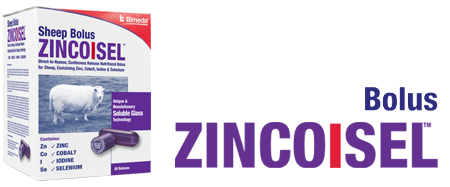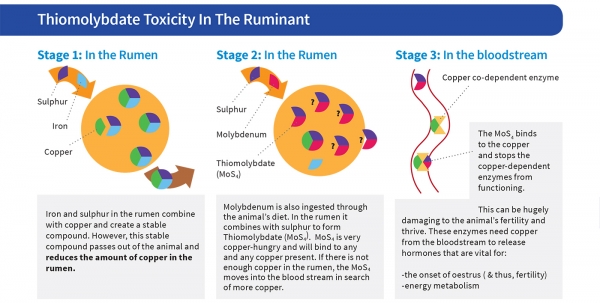The Thiomolybdate Story
Symptoms such as bald ears, spectacles, rusty coloured coats are often mis-diagnosed as ‘copper deficiency’. What is actually happening is that iron and sulphur are binding to copper in the rumen to reduce the copper available to the animal.
When reduced fertility, poor DLWG and lower milk yields become apparent, blood tests are carried out to find out what’s wrong. All too often the results come back to say that blood copper levels are normal. This often occurs when molybdenum is also present in the diet.
Sulphur and molybdenum together form a very 'copper hungry' compound called thiomolybdate. If there is enough copper in the rumen, it will bind to this and pass out of the animal harmlessly. BUT, if the iron/sulphur compounds in the rumen have already depleted rumen copper levels, the thiomolybdate moves into the blood stream to find more copper. This is where the damage happens.
Copper is a vital element in the enzymes that release Follicle Stimulating Hormone (FSH) - vital for initiation of the oestrus cycle, Luteinizing Hormone (LH) - vital for completion of oestrus cycle, and many other enzymes such as Cytochrome c Oxidase which is part of the electron transfer chain that transfers energy from feed in the rumen to cells in the body. By depleting FSH and LH, thiomolybdate severely affects reproduction. Depleting Cytochrome c Oxidase reduces the amount of energy absorbed in to the body and therefore reduces milk production or liveweight gain - or both.
There are many other enzymes performing smaller functions in the body that are affected by thiomolybdate. Tyrosinase - a copper dependant enzyme used in the production of the black hair pigment, melanin, is one. Reduction of this enzyme is what causes the 'rusty' coloured coats on black animals.
Detecting thiomolybdate is a problem many vets do not consider. Traditional blood tests do not show it because the copper is still in the blood stream (albeit bound to thiomolybdate and completely useless to the animal!) and therefore they come back showing normal or high copper levels even though the animal is still exhibiting bald ears, bare eyes, rusty coat, etc. A caeruloplasmin copper test is needed show the true levels of functional copper enzymes.
Thiomolybdate toxicity cannot be treated with copper-sulphate or copper-oxide.
Download Caeruloplasmin Test request form
Download Outline of NuVetNA Services & FAQs



